
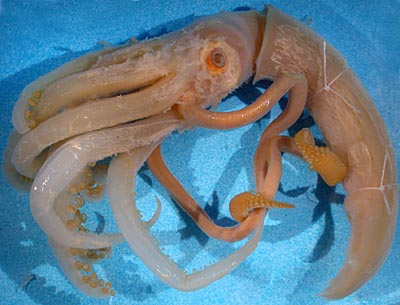
Figure. Lateral view of the specimen of N. thielei that most of the following description is based on, 100 mm ML, N. Pacific.
- Arms
- Arms I shortest; arms II-IV subequal.
- Largest suckers of arms I-III approximally equal in size (2.7 mm diam.); largest suckers of arms IV much smaller (1.1 mm diam.)(See photograph on below.).
- Delicate protective membranes without obvious trabeculae present on arms (badly damaged in specimen examined).
- Tentacles
- Locking apparatus
- "Carpal" locking suckers and knobs absent (see photograph at right showing absence of a locking apparatus at the base of the manus); locking suckers and knobs along tentacle stalk absent.
- Manal locking suckers present; evenly but broadly spaced along dorsal margin of proximal-manus in single series (see photograph on species page); difficult to recognize from normal manal suckers proximally and distally on present specimen. Locking knobs not seen.
- Manus
- Distal-manus with abruptly larger suckers than proximal-manus (about 2-4 suckers are of intermediate size).
- Club expanded, maximum width across proximal-manus ca 8% of ML.
- Suckers of proximal-manus very small, smaller at proximal end (0.2 mm proximally, 0.25mm distally); about 35 suckers across maximum width of proximal-manus near distal end; about 25 suckers across proximal-manus near proximal end where club first expands.Suckers have round aperatures. The above photographs show three different regions of the proximal-manus (left - distal end; middle - slightly more proximal; right - well proximal).
- Dactylus and terminal pad
- About 5 suckers initially across distal-manus but shortly becomes four regular series as it grades into dactylus and throughout dactylus.
- Terminal pad (=distal locking-apparatus) with 16-20 suckers but difficult to determine where dactylus suckers end and pad suckers begin. Pad suckers form a circle with a central space and the sides of the circle are composed of two series of suckers.
- Head
- Eyes large, diameter 18% of ML.
- Buccal connectives attach to dorsal margins of arms IV.
- Occipital folds absent.
- Olfactory organ on short stalk.
- Beaks not examined.
- Mantle
- Mantle wall thick but spongy; arms extremely delicate.
- Fins
- Fins separate throughout length; separation increases anteriorly; anteriorly attach to sides of mantle. (In the title photograph, the long fins reach to the anterior most string tied around the mantle.)
- Fins slender, combined width 30% of ML.
- Posterior lobes probably present (damaged); without anterior lobes.
- Photophores
- Photophores absent.
- Gladius
- The morphometrics of the gladius have been reported by Toll, 1982: Gladius length - 105.6 mm; free rhachis length - 12.2 mm; free rhachis width - 4.3 mm; maximum gladius width (across vanes) - 8.0 mm; conus length - 2.0 mm.
- Pigmentation
- Buccal membrane unpigmented; no pigment remains on animal surface. Remnants of thick white tissue present on aboral surfaces of arms, surfaces of head and thin traces on mantle (see title photograph).
- Measurements

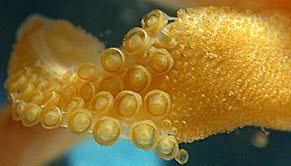
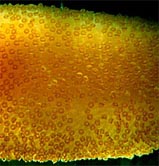
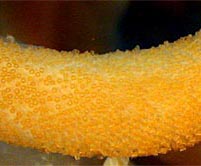
Figure. Oral view of portions of the club of N. thielei, 100 mm ML, N. Pacific. Left - Region where the proximal- and distal-manus regions meet. Middle - Distal region of the proximal-manus. Right - Proximal region of the proximal-manus. Photograph by R. Young.
| Specimen | USNMNH 730705 |
| Sex | Female |
| Mantle length, mm | 100 |
| Mantle width | 19 |
| Head length | 26 |
| Head width | 23 |
| Arm length I, Left / Right | 58 / - |
| Arm length II | 76 / 57 |
| Arm length III | 84 / - |
| Arm length IV | 87 / 93 |
| Club length | 63 / 59 |
Comments
The gladius was previously removed by R. Toll, but it remains in the jar with the squid. This squid is a female.
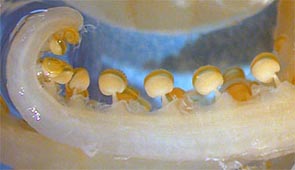
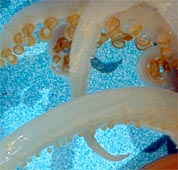
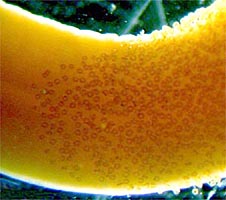
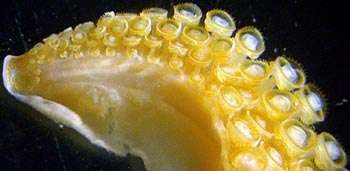
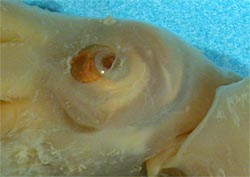

 Go to quick links
Go to quick search
Go to navigation for this section of the ToL site
Go to detailed links for the ToL site
Go to quick links
Go to quick search
Go to navigation for this section of the ToL site
Go to detailed links for the ToL site